Physics at ECU
While much of the research conducted in the Department of Physics at ECU is focused on the physics associated with biological phenomena and medicine, other important fields in physics are also represented, including statistical, atomic, molecular, radiation, optical, and high-energy.
Merging biology, medicine, and optics, Xin-Hua Hu in the Biomedical Laser Laboratory conducts multidisciplinary research in biomedical optics. Dr. Hu’s efforts are focused on understanding how biological cells interact with light. One of the long term goals of his research, for example, is to develop a device that shines light on a cell and then “sees” whether the cell is cancerous or not. On a related front, Yongqing Li of the Biomedical Optics Laboratory traps cells, spores, or viruses in a laser beam with the goal of manipulating or examining them. The underlying aim of his research is to better identify and understand biological samples and processes at microscopic scales.
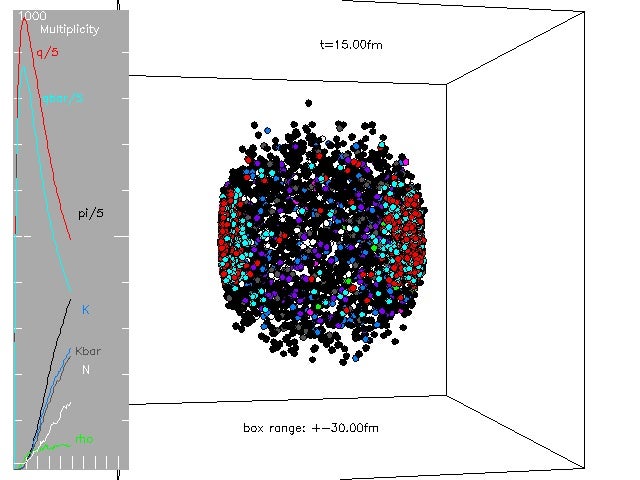
A single collision of two high-energy gold nuclei from the AMPT model.
In high energy physics, Zi-Wei Lin conducts research at the smallest possible scale: quarks and gluons. These can be emitted when particles or nuclei collide at nearly the speed of light under laboratory conditions. The resulting “quark-gluon plasma” is interesting in the context of the Big Bang, in which the early universe evolved on time scales of microseconds, or one-millionth of a second. This primordial matter eventually cooled and fused to become the more familiar constituents such as protons and neutrons, resulting in the chemical elements, biology, and ultimately ourselves.
As an example of this process, consider the collision shown in the figure. The two nuclei come from the left and right side, respectively. Here time starts from the instant when the two nuclei overlap; the box is 60 femtometers (i.e., 60 quadrillionth of a meter) in length along each axis, and the time of 15 femtometers (over the speed of light) is equal to 5×10-23 second. Partons such as quarks (in red) and antiquarks (in cyan) are produced first and then interact with each other, and then partons gradually convert to hadrons. The numbers of different particles versus time are shown in the left panel. The evolution of the matter at the far right or the far left side has a strong time dilation due to Einstein’s theory of special relativity, so partons can still be seen there while almost all partons in the middle have already converted to hadrons.
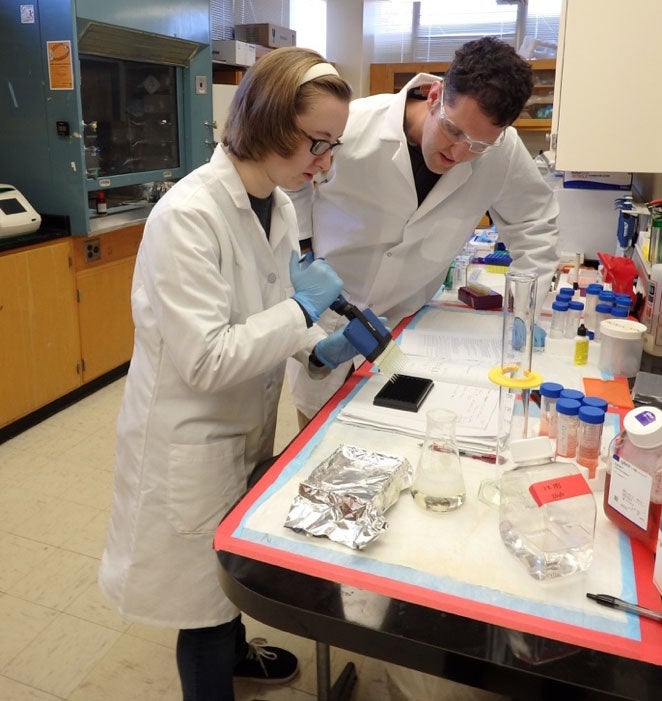
Dr. Nathan Hudson’s research group works to develop novel fibrinogen proteins with altered mechanical properties to test hypotheses on the origins of blood clot elasticity.
Juan Beltran-Huarac is devoted to understanding the interaction between nanomaterials and tumor micro-environments in exogenous magnetic fields with the goal of treating cancer more effectively in a non-invasive manner. He leads the Magnetic Formulations and Bionanotechnology Laboratory, where contrast agents for magnetic resonance imaging (MRI) are developed. His research group aims to demonstrate the value of new technologies in magnetic cancer treatment.
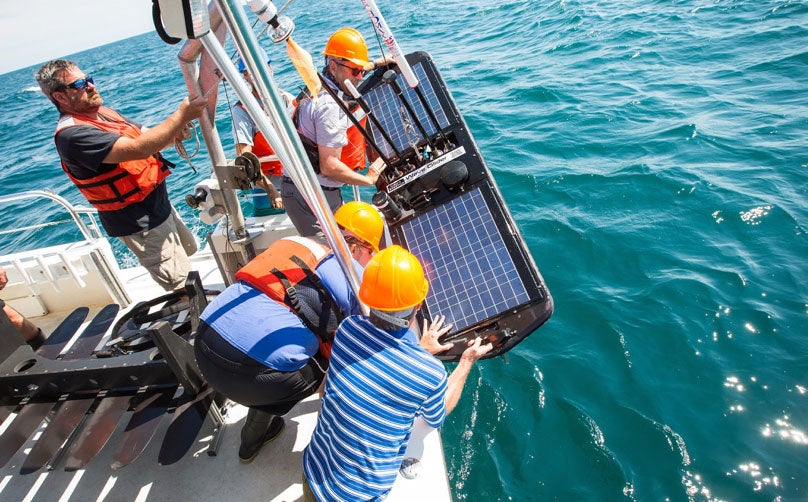
Dr. Mark Sprague and the ECU Wave Glider team recover Blackbeard, the acoustic Wave Glider, from deployment in Onslow Bay, where it made sound recordings and gathered other oceanographic data.
Merging biology and acoustics, Mark Sprague conducts research in the relatively new field of bioacoustics. His research group detects and interprets the sounds that various species of fish produce. Furthermore, his research investigates how noise pollution can initiate a fright response in animals, or how this pollution acts to overwhelm the sounds that these animals rely on to survive.
In statistical physics, researchers seek to determine how atomic scale interactions lead to phenomena like boiling point, magnetism, or elasticity. The methods of statistical physics have been used to understand many biological systems, or complex systems in general. To this end, Martin Bier seeks to understand how, for example, a viral disease propagates through a population.
Atomic, molecular, radiation, and optical (AMRO) physics studies the interaction between radiation and matter at the molecular scale. Modern medicine is highly dependent on AMRO applications, as the many techniques to “photograph” the inside of a patient all derive from this type of research. Additionally, radiation therapy (radiotherapy) in the treatment of inoperable tumors, as well as laser surgery, are other prominent AMRO applications. The centerpiece of AMRO research at East Carolina University is the department’s Accelerator Laboratory.
Gregory Lapicki developed the ECUSAR theory for ionization cross sections by protons and heavier ions in atomic inner shells. He compiles and calculates them as required for reliable analyses of elemental composition and concentration of materials as it is done with the particle-induced x-ray emission (PIXE) technique.
Jefferson Shinpaugh and Michael Dingfelder study the effects of ionizing radiation on biological matter from experimental and theoretical points of view, respectively. Understanding how radiation damages DNA and cells in general is key to eventually determining the origins of many types of cancer.
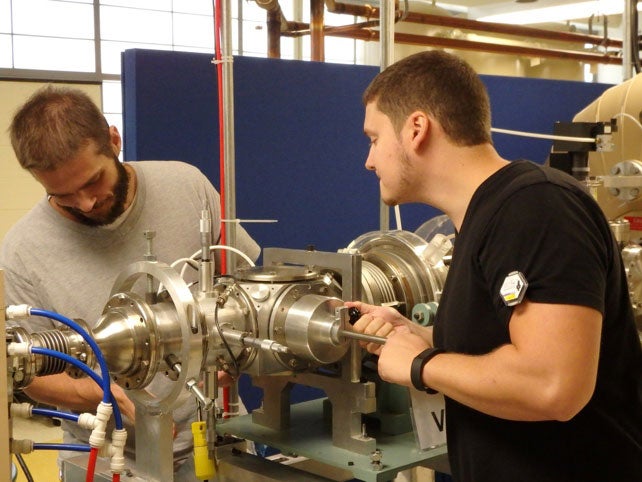
Graduate students conduct research in radiation physics in the Accelerator Laboratory.
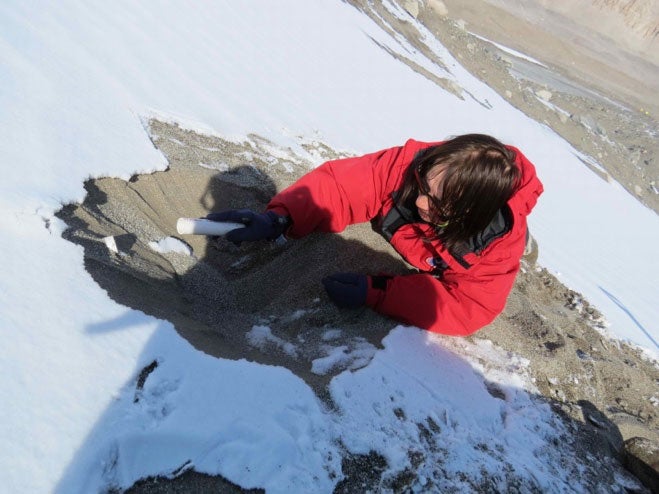
Dr. Regina DeWitt collects samples for luminescence dating in the McMurdo Dry Valleys, Antarctica.
Regina DeWitt frequently collaborates with geologists to study radiation damage in minerals. Such knowledge can be used, for example, to determine the age of an inorganic artifact based on how much light it emits under specific laboratory conditions. Furthermore, the techniques that the Optically Stimulated Luminescence Laboratory is developing can be used to monitor the potentially harmful radiation exposure of radiation workers and cancer patients. Her research group recently performed field work in Antarctica with the aim of determining the age of boulders along the coast line. Their results are important for building an understanding of coastline evolution and climate change.
Joel DeWitt studies the space radiation shielding possibilities applicable to future spacecraft or planetary surface habitats. He is focused on novel and/or optimized materials that act to maximize the protection of space crews from ionizing radiation while minimizing the cost of their implementation. The study of space radiation shielding is important because of the known short- and long-term detrimental effects ionizing radiation can have on human physiology.

The use of radiation transport codes such as FLUKA could help answer basic questions about galactic cosmic ray (GCR) interactions with shielding.